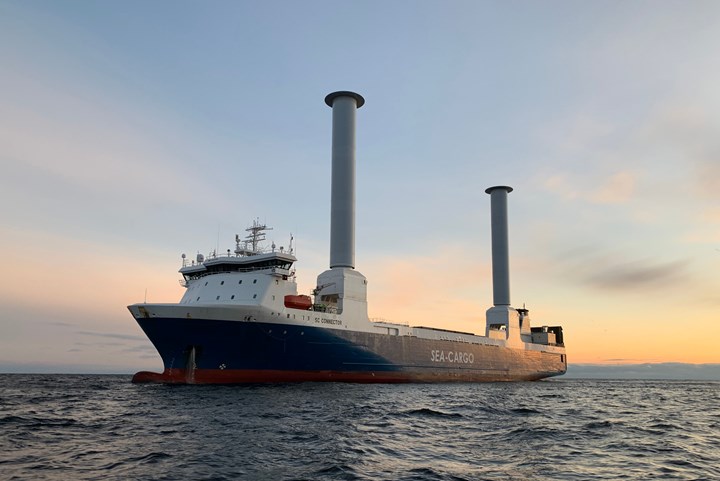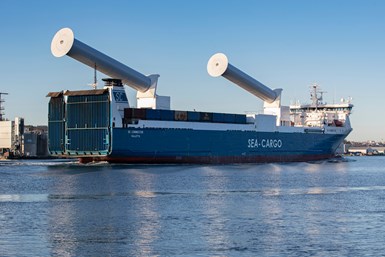Norsepower installs tiltable composite rotor sails on Sea-Cargo RoRo
Installation of two 35-meter-tall rotor sails are estimated to reduce fuel consumption, fuel costs and emissions by as much as 25%.
Share

Sea-Cargo’s SC Connector. All photo credit: Sea-Cargo, Norsepower
Provider of auxiliary wind propulsion systems, Norsepower (Helsinki, Finland) reported on Jan. 20 that it has successfully installed two 35-meter-tall composite rotor sails for Sea-Cargo, a logistics provider in the north sea market. A modernized version of the Flettner rotor — a spinning cylinder that uses the Magnus effect to harness wind power to thrust a ship (see CW’s coverage on the sail’s design) — Norsepower says this installation heralds the world’s first tiltable rotor sail, showcasing that vessels that have to negotiate height restricted routes can benefit from this fuel- and emissions-saving solution.
According to an analysis conducted by Norsepower and Sea-Cargo, the installation — on board the SC Connector, a 12,251 gross tonne (GT) sidedoor RoRo — can achieve a fuel consumption, fuel cost and carbon emissions reduction of up to 25%. In good wind conditions, Norsepower says the sailing vessel will maintain regular service speed by sail alone. This is especially important as shipping transitions towards decarbonization and attempts to meeting International Maritime Organization (IMO, London, U.K.) 2030 and 2050 targets.
SC Connector, which sails between Western Norway, Denmark, the Netherlands, as well as Sweden and Poland, transits under multiple bridges and powerlines, requiring adaptation of the rotor sales to tilt to a near horizontal angle when required.

“Completing the installation has been rewarding, as it reflects how, in taking a collaborative approach with a customer, we can innovate to create solutions that allow rotor sails to benefit almost any vessel type or trading route,” says Tuomas Riski, CEO, Norsepower. “As we get closer to 2030 IMO targets, we are seeing our technology gaining momentum, with the market realizing the flexibility we can provide to suit different vessel requirements. This installation demonstrates the technology can go a long way to future proofing IMO GHG [greenhouse gas] compliance, while ensuring significant emissions, and fuel reductions to a variety of vessel profiles today.”
According to Ole Sævild, managing director, Sea-Cargo, the company is focusing on using available renewable energy for direct propulsion to design more environmentally friendly vessels. “The rotor sail technology has been proven in the market for a while, but the size is unique for our project. The sails are far more efficient than conventional sails of the same size and the tilting function is essential to our voyage routes. Given the estimated emissions savings, we will use our experience of this full-scale project, and proceed to develop it further for other vessels in our fleet.”
According to Norsepower, its composite rotor sail is the first third-party verified and commercially operational auxiliary wind propulsion technology for the global maritime industry.
Related Content
-
The lessons behind OceanGate
Carbon fiber composites faced much criticism in the wake of the OceanGate submersible accident. CW’s publisher Jeff Sloan explains that it’s not that simple.
-
Large-format 3D printing enables toolless, rapid production for AUVs
Dive Technologies started by 3D printing prototypes of its composite autonomous underwater vehicles, but AM became the solution for customizable, toolless production.
-
Composites end markets: Boatbuilding and marine (2025)
As 2023-2024 consumer demand slows, boat and marine vessel manufacturers continue to focus on decarbonization and new technologies using composites.















